This is a guest post by Chris Lange.
I live with my whanau in a quiet cul-de-sac street in Massey, West Auckland. At the request of fellow residents our street was lucky enough to be chosen to take part in Waka Kotahi NZ Transport Agency’s Innovating Streets for People programme. This programme aims to make it faster and easier to transition our streets to safer and more liveable spaces. Our role was as a Play Street which involved temporarily closing a small part of our street to non-resident’s cars to run several play street events.
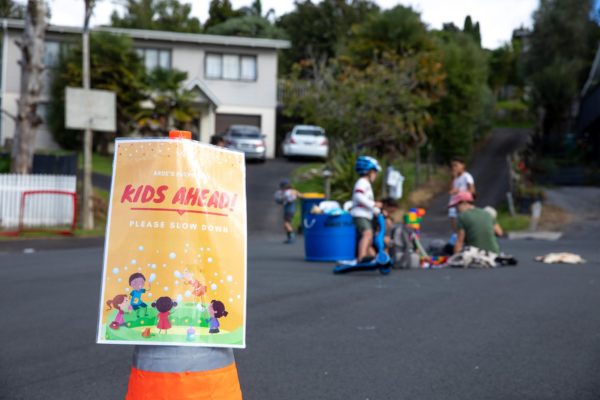
Although these were temporary events, they have seen long term benefits for the local community. It has given our street a sense of connectedness with the place and one another. It is a daily occurrence for children from our street as well as neighboring streets to come together to play outdoors. It has become a shared space we enjoy together.
It was wonderful being a part of the programme right from the beginning. After trialing the first event it was clear there was appetite from the community for more. Local children were invited to share their ideas during the planning, then we set about implementing as many of their ideas as we could. Turns out they were event planning experts! By the time all the events were done we had done a wide variety of activities. This included lots of sports, a range of new toys, art, and fun with bikes. We even invited our local police to come show off their police car and got to play with the flashing lights.
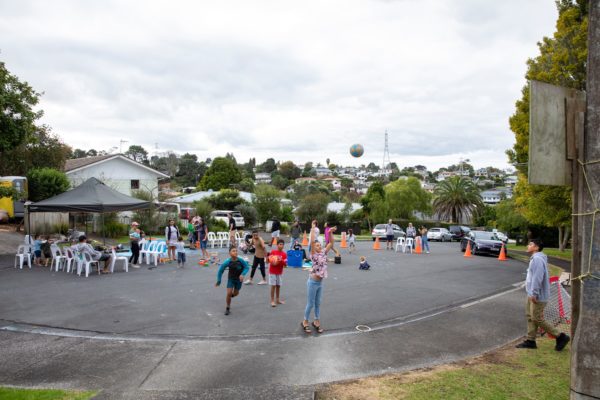
As part of the initial programme, funding was made available to create a compact, raised planter box as a traffic calming measure, complete with a mandarin tree for the kids. Permission for this was checked with Auckland Transport and it was built, painted and planted over the course of the events mainly by volunteers, including many children.
For many months it performed well and was an asset to our street. So, you can imagine my surprise when I learned that AT was ordering it urgently removed, labelling our humble mandarin tree an ‘encroachment’ which was a ‘serious hazard to children’. Little did we know that according to some within AT our tree was not permitted outside the event times. It appears that miscommunication within and between the different organisations had occurred.
I completely understand needing to comply with the rules and enforcement of them, however this was not some rogue action, but families contributing to the ‘Innovating Streets For People’ programme to make our street a safer place.
Given the misunderstanding I felt it would have been appropriate for AT to work with Council and their partners to explore possible solutions. Attempts at this failed as AT insisted it be removed immediately threatening to escalate the situation to legal proceedings against those involved. I felt this was an unnecessarily hardline response. Under threat from AT, volunteers reluctantly dismantled the planter box and transplanted the tree.
This experience highlighted the inconsistency in Auckland Transport’s enforcement of the rules. Take a walk around our neighborhood and you will see there is no hardline approach to enforcement when it comes to rules for cars. Hopefully you don’t need to take a pram or wheelchair as every day our area is littered with illegally parked cars blocking our footpaths forcing children to walk into live lanes. The few unprotected cycle lanes we have are no safer as motorists commonly either drive or park in them. It really is the wild west as these daily and serious encroachments are largely left unchecked. Instead AT relies on individuals to spend their own time waiting on the phone to them for something to be done about it. There doesn’t appear to be any sense of urgency from AT to address these hazards.
This inconsistency is in stark contrast to AT’s Vision Zero goal of no deaths or serious injuries on our transport system by 2050. If our city is to achieve this, then we need AT to do much better with enforcing the current rules so that vulnerable road users are kept safe. As residents we should be expecting AT to not just say the right things but walk their own talk.
As for our community’s illegally parked mandarin tree, rest assured it no longer causes a ‘serious hazard.’ It has now been replaced with a parked car.
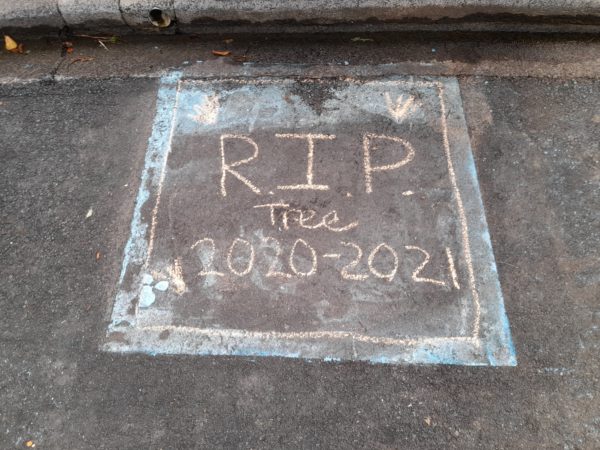
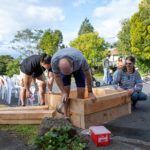
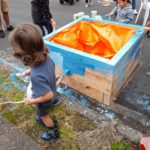
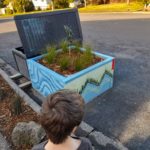

 Processing...
Processing...
Hmmmm. RIP tree indeed. What I think you need to do is to aim for More Trees. Have a look at this inspiring story from Fantame St in Porirua: https://www.wesleyca.org.nz/people-power-sees-big-changes-at-the-fantame-street-shops-in-cannons-creek/
You should have built the planter with wheels then it could be parked there.
Sounds like AT missed out on their cut.
My thoughts exactly Stu.
A car-shaped planter with low-growing grasses/shrubs. How could AT complain then?
Parking ticket
Might have trouble finding a licence plate. / vin
This story about allowing local residents to repurpose carparks in the Netherlands appeared in the Guardian a few years ago.
https://www.theguardian.com/world/2018/may/17/sun-terraces-and-lawns-dutch-residents-transform-parking-spaces
The article notes that “The idea of a parking space being lost from a street was too much for some to bear.” “Everybody took – and this in the Netherlands is more rare than in other countries – very opposite positions. Normally, we are a country where we have a dialogue, we talk to each other.”
Heavy enforcement to stop something good? Given AT’s track record on enforcement, they are intentionally making a point.
F*** knows what the point is, though.
Hmm. May I suggest getting a Ute, placing the box and tree in the tray, and then parking the ute in place. Then there can obviously be no problem.
And to make sure, park the ute on the berm where parking is permitted. Take care though not to damage that berm because the $70k that AT is spending annually on repairs appears to be to the detriment of adding extra bike lanes, because the pot is empty.
This permitted parking should not be confused with Permitted Parking Zones. This is where AT arbitrarily draws lines on a map for proposed zones; spends endless months consulting, at seemingly huge expense ; forgets that they could have managed this by a demand pricing strategy; and in the end decides the same thing as the local regressive business association wanted.
Pro tip: if any of your neighbours own a trailer, it is legal to park a trailer on the road for up to a week at a time. Place your planter box on a trailer and park it up. Move your trailer once a week. Alternatively, you can buy a warranted second hand trailer for as little as $200.
Some timber for a planter, some paint and a tree? You really missed a trick there. WK had Gazillions of dollars to hand out for any daft idea. Had you spent several hundred thousand of public money or maybe even millions then AT would have been embarrassed enough to try and make you keep it.
“Gazillions of dollars” are certainly being spent by WK in other programmes – on continuing to build an unsafe and high carbon transport system.
“Gazillions of dollars” have not been spent on the Innovating Streets projects, which are designed to test the barriers to building a safe and low carbon transport system.
Some of the barriers exposed have been the level of disinformation that conventional practitioners are willing to indulge in, both exaggerating the costs and dismissing the benefits. Kind of fun really to see what dicky thing they are willing to say next. 🙂
It is interesting that people had to fight to get rid of projects AT was involved in, but they have to fight to keep the projects AT didn’t do.
My grandfather, born 1902, used to tell me that fruit near the footbath was public fruit and when walking past you were allowed to take some. Seems a good way to encourage walking.
Too right! You can still do that in some of Aucklands older streets, in Mt Albert for example
//embedr.flickr.com/assets/client-code.js
Computer says no.
https://flic.kr/p/2fyD1Ri
And I thought the headline was about monolingual signage …
Innovating streets is such a great initiative in theory.
Unfortunately in this case it has fallen prey to AT and Councils disfunctional communication.
What could have been a fantastic exersize that facilitated community building and kids getting out and being active and social, has turned into an exersize in community building through shared disgruntledness at stupid bureaucratic enforcement of bylaws.
In short, screw your innovation and community building. The parking is more important!
‘serious hazard to children’. Oh really. So AT can’t even be honest about why they want it gone.
A little off topic but some great news about bus signs changing from numbers to locations:
“The key difference is that the new names will use the physical surroundings of bus stops such as nearby interchanges or landmarks, making the new bus stop names more recognisable. These new names will make it easier for you to travel around, and will help our blind and low vision community navigate where they need to go.”
Without being disrespectful is it for the benefit of the blind person’s dog, or is something else going on that I have missed.
The vast majority of people in the blind low vision community are not fully blind. More that seeing any details is impossible. Telling large shapes like a stop outside a distinctly pointy church or any large distinctive building, or if you’re across from a park is much easier than reading some inconsistency styled and placed numbered signs on buildings.
Same goes if you’re on a bus looking where to get off, or looking for a stop to get on one.
I’d put myself in that category. I think this is a good change.
So a sign that says, “Mt Eden Domain” rather than “281 Mt Eden Road” is a complete waste of time because they can’t see the sign and they are looking for the domain anyway?
Heidi
I don’t get it, I’m sorry.
Because the stop is called that, all the references will be “Mt Eden Domain”. Its not just on the stop itself, but online, on the planners, the app etc.
So when you’re planning your journey you will learn I’m getting off or on at “Mt Eden Domain”. You are more likely to be able to see the large green area or big gap in the buildings / higher light level, and know that’s the stop to get off or catch your bus. Not relying on the little writing on the stop at all any more but the large distinctive feature of the stop or around it.
This will work well in some places, probably wont make much difference in others.
The sign change will be for the rest of the population that can read these things. And I think the majority of the benefit is for everyone. Having solid names for stops is far better than an address. We don’t do that with trains, Newmarket station isn’t 250 Broadway. Having named stops helps everyone (including low vision people) think about / imagine where they’re going. I think the extra help for the blind low vision community is a good extra plus they want to talk up in their marketing, it will make a decent positive difference in some peoples lives though.
Imagine that you are blind enough that you can’t drive, but have enough vision to see some tactile pavers, or recognise a large grassed area vs concrete, vs the sea, vs a concrete building, vs a glass building etc, and the approximate size of the building. That is the most common level of vision loss in NZ that also meets the legal definition of being blind.
Now imagine that you are catching a bus on Queen Street. And need to get off at 400 Queen Street.
How do you tell where 400 Queen Street is? You don’t even as a sighted person, I’ve never been able to do this on any streets, because buses are moving to fast.
Now imagine that you are doing the same thing, but you need to get off at Aotea Square.
How do you tell where Aotea Square is? You look outside the window and see the large open square, then get off of the bus.
Similar logic also applies to examples such as ‘Victoria Park’, ‘Mission Bay’, ‘Panmure Station’. This is how most people actually talk about transfers already.
More to the point, why the fffff do our buses not have scrolling stop displays (let alone proper info screens like the link buses) and announcements with the upcoming stop name and transfer opportunities. I remember being a teenager without a smartphone and having to ask the bus driver to let me know when to get off when catching a bus to a new part of town. No idea how a tourist would manage.
I have caught many a bus in many countries including ones much poorer than NZ and they’ve always had these features. You’d think it’d be a bare minimum feature here.
https://at.govt.nz/about-us/news-events/easier-travels-around-t%C4%81maki-makaurau-with-new-bus-stop-names/
Later this year audio announcements will be introduced across buses with announcements in te reo Māori and English, as well as other helpful information for customers such as transfer messages and special events updates
They say they are partially solving this now.
I personally hate the announcement barrage on the trains, but they are clearly a benefit overall.
Nice post
AT should feel mortally embarrassed!
And put it right!!
Ralph
Thanks Chris – great post.
Im envious of your kid friendly street,
Clearly – “streets are for people” not trees.
Your article is about bureaucracy, also power, but really its a taste of the battle for our streets and who owns what. Clearly you crossed a boundary.
As a ratepayer – i do not endorse legal proceedings against you our your kids for your actions. I want my money back on that one.
re “AT working with Council” – AT is the council – despite Rodney Hide moving it as far out as possible – the CCO review stated this clearly, also that the CCO’s are not businesses.
Rather than remove the offending tree – i would love for you to find the cutest 3yo and put their name as the responsible party and follow the case through.
This is not council over-reach – but a clear statement. These roads belong to the council.
Congrats – and i hope once Covid is sorted – you can have some excellent street parties – gather and sing songs of the mandarins that could have been, and the day the big council came to your street.
We’re from Local Government and we’re here to help you -joke. I’d definitely contribute to the aforementioned 3yr olds legal defence via their givealittle page should it come to that.
When Labour took office in 2017 it came as a breath of fresh air and seemingly a breath of fresh ideas. Why then is it taking so long to purge the layers of sub-government, of people who are clearly not with-the-programme and have clearly passed their use-by date?
Labour is full of the same Status Quo people. Why do you think nothing has changed in 5 years? Housing, climate change, taxation… all baby steps only while the world ignores them.
To quote the PM, “Radical change takes time”.
??
if you want a conservative government, two ticks labour
Maybe we should do that? Imagine the publicity of AT taking on a child and their Mandarin tree. And a well funded child at that.
Might open the floodgates all over the region?
A response to Mr Plod, above.
What is the purpose of traffic calming at the end of a dead-end street?
To calm traffic. Motorists can’t even be trusted to behave on their own street around their neighbours’ kids
The mistake was made when you and your community complied with the silly rules and policies.
I mistakenly thought that there was a danger to the children from a mandarin driver who percieves that a road is exactly what it is built for the movement of vehicles. My bad!!
Roads are built for the use of the community, which may include the movement of vehicles.
Hi Chris! “A sense of connectedness with the place and one another” is exactly what placemaking is about. You might want to consider nominating this activation for the Kūmara Awards in Tāmaki Makaurau – you can do it with no fee before October 1. It is an initiative of Placemaking Aotearoa (placemaking.nz) and aims to celebrate all fabulous placemaking happening around and acknowledge people behind the scenes. This project is fantastic!
so it’s okay for planter box’s to be dumped on main roads and to block intersections and not be dangerous to children adults and more to road users that pay for the roads like in Henderson and Onehunga by both AT and other government departments that are not wanted but something asked for by the locals in the street they can not have its time for these woke government and local government departments to go or a change of staff starting at the very top